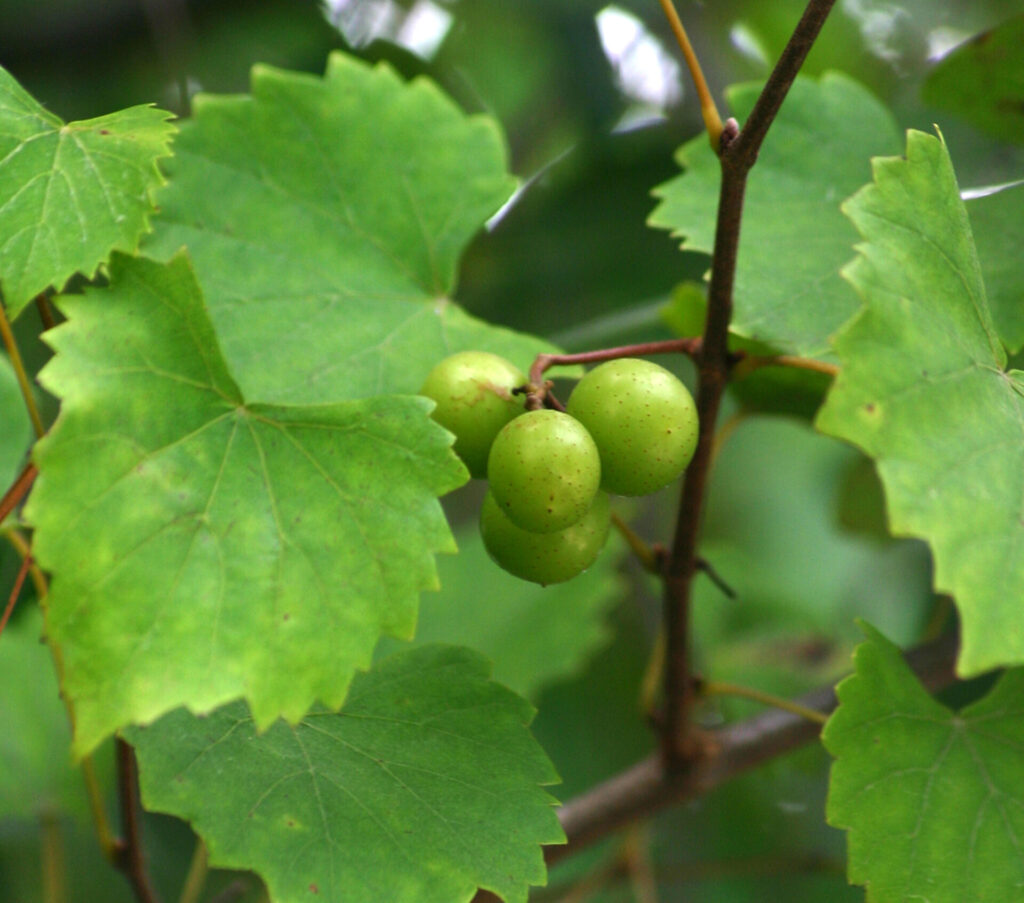Training is bending, tying, or pruning a plant or branch into a particular shape
or position onto a trellis system. In the first year, select a vigorous shoot that will grow up the training
stake and become the trunk of the vine. Remove any other shoots as they develop during this time
to encourage one robust, upright shoot that will develop into a healthy, permanent trunk. Allow this
main shoot to grow upward until it reaches the top wire, making sure to tie it to the training stake
along the way. This may occur during the first season, but if it does not, prune the main shoot back
down to two buds during the dormant season before growth commences in the second year,
beginning the process again. (Avoid the common mistake of retaining a small or weak cane in hopes
of building a trunk more quickly).
Once the main shoot reaches one foot beyond the top wire, cut it back to a few inches below the wire
to encourage lateral shoot growth. Shoots will grow from buds just below where the shoot was cut.
Select two lateral shoots—one to the right and one to the left—at or below the point where they
touch the wire. Each lateral shoot will serve as an “arm” (cordon) of the grapevine and can then be
trained along the cordon wire. The cordon can sometimes develop to the full length of the wire during
the second growing season. Depending on the health of the vine, soil conditions, and weather, newly
planted muscadines may grow anywhere from a few feet to over 10 feet within a single year. You can
also retain two trunks rather than a single one.
To train vines into an arbor, during the first 2 years, train the vine up the arbor post. In the third year,
establish a cordon down the wire, with horizontal bars (cross-members) spaced 24 inches apart. In
January or February, prune the cordon to two or three bud spurs every 4 to 6 inches.
Prevent overgrowth by establishing cordons at least than 48 inches apart. If you use only one
cultivar and want it to fruit, be sure it is a perfect plant, one that is self-fruitful and does not require a
pollinizer. Choose a bronze-colored cultivar if a patio or concrete surface is below the arbor and
staining from fruit drop is a concern.
Vines may die if they are in standing water for even a short
period of time, such as after a heavy rainstorm. mulch around the bases to aid in water retention.
The first year is key. After that, they may do fine with just rainfall.
Irrigation is most likely needed for vineyard establishment. It would be crucial for fruit sizing and to
maintain vine health and fruit quality during dry periods. Irrigation requirements depend on soil, vine
size, and weather conditions. Adjust the watering rates to compensate for extremes in soil drainage
or weather events. (Water quality may need monitoring from its source).
Muscadine roots are very shallow. To prevent root damage, avoid
mechanical tillage. Control weeds in first-year vines by either hoeing a 3-foot circle around each
vine. Do not underestimate the importance of weed control. It is one of the most significant
challenges for new vineyards.
Fertilizers, particularly nitrogen, applied after harvest
stimulate late season growth which decreases cold hardiness. Feed with compost, rabbit manure,
and compost tea can do well without any chemical fertilizer. Feed with slow-release organic
matter like manure/compost any time. If you’re using something like blood meal or 10- 10-10,
however, just feed at the beginning of the year as they’re waking up, then another hit or two into
the summer.
Conduct a soil test before planting a muscadine vineyard to determine if pre-plant amendments are
necessary. Your soil test should guide your first-year nutrition program. For instance, sandy soil has
a relatively low nutrient-holding capacity. As a result, muscadines grown on sandy soil will require
more frequent applications of fertilizer.
Compared to improved bunch grapes, muscadines have excellent
disease resistance. However, a disease-control program remains necessary to maximize production
and fruit quality. // Bunch rots such as bitter rot, ripe rot, and macrophoma rot are the most common
threats, and often warrant control, particularly in wet years. The grape berry moth is the most
common insect pest of muscadines and bunch grapes. It lays its eggs on developing flower and fruit
clusters, where the larvae infest. A single larva can infest and destroy several flowers or berries,
reducing yield and quality.
The grapes may be susceptible to parasitic nematodes. One grower’s recipe is to have coffee,
tobacco, pokeweed, pencil tree leaves, cassava leaves, habenero peppers, moringa, comfrey, dog
fennel, rosemary, mint, senna alata and oregano to combat. While many species of nematodes are
pests, some are actually beneficial to the garden. It is important to note that soil-borne and plant loving nematodes are not the same species as the roundworms that sometimes inhabit humans and pets.
Japanese beetles do love a nibble, however, as do birds. Draping netting over the vines can
thwart the birds.
Grow your own painted daisies and use the flowers as a fungicide for plants. Dry the flower heads,
then grind them or soak overnight in 1/8 cup (29.5 mL) of alcohol. Mix with up to 4 gallons (15 L.) of
water and strain through cheesecloth. Bordeaux mixture for use during the dormant season can
control some fungal and bacterial diseases. Fungal disease severity is increased by dense leaf
canopies which maintain high humidity. Canopy modification using proper pruning and fertility
management can reduce disease problems.There are a number of disease resistant cultivars to
choose from too, such as: Carlos, Nesbitt, Noble,Triumph, and Regale.






